Mnemosyne Atlas 6
Tipologie di preformazioni antiche
3. Il raptus sacrificale
Le formule gestuali che esprimono gli aspetti opposti del sacrificio: l’immagine attiva del carnefice (Aiace; sacerdote e Menade-sacerdotessa; danza rituale: danza del sacerdote e della Menade; danza funeraria; ‘danza’ di Achille a Sciro) l’immagine passiva della vittima (Laocoonte come sacerdote sacrificato; Polissena; Cassandra).
Types of ancient pre-coinages
3. The sacrificial raptus
Gestural formulae expressing opposing aspects of sacrifice: the active image of the executioner (Ajax; priest and Maenad-priestess; ritual dance: dance of the priest and Maenad; funeral dance; 'dance' of Achilles at Skyros) and the passive image of the victim (Laocoon as the sacrificed priest; Polyxena; Cassandra).
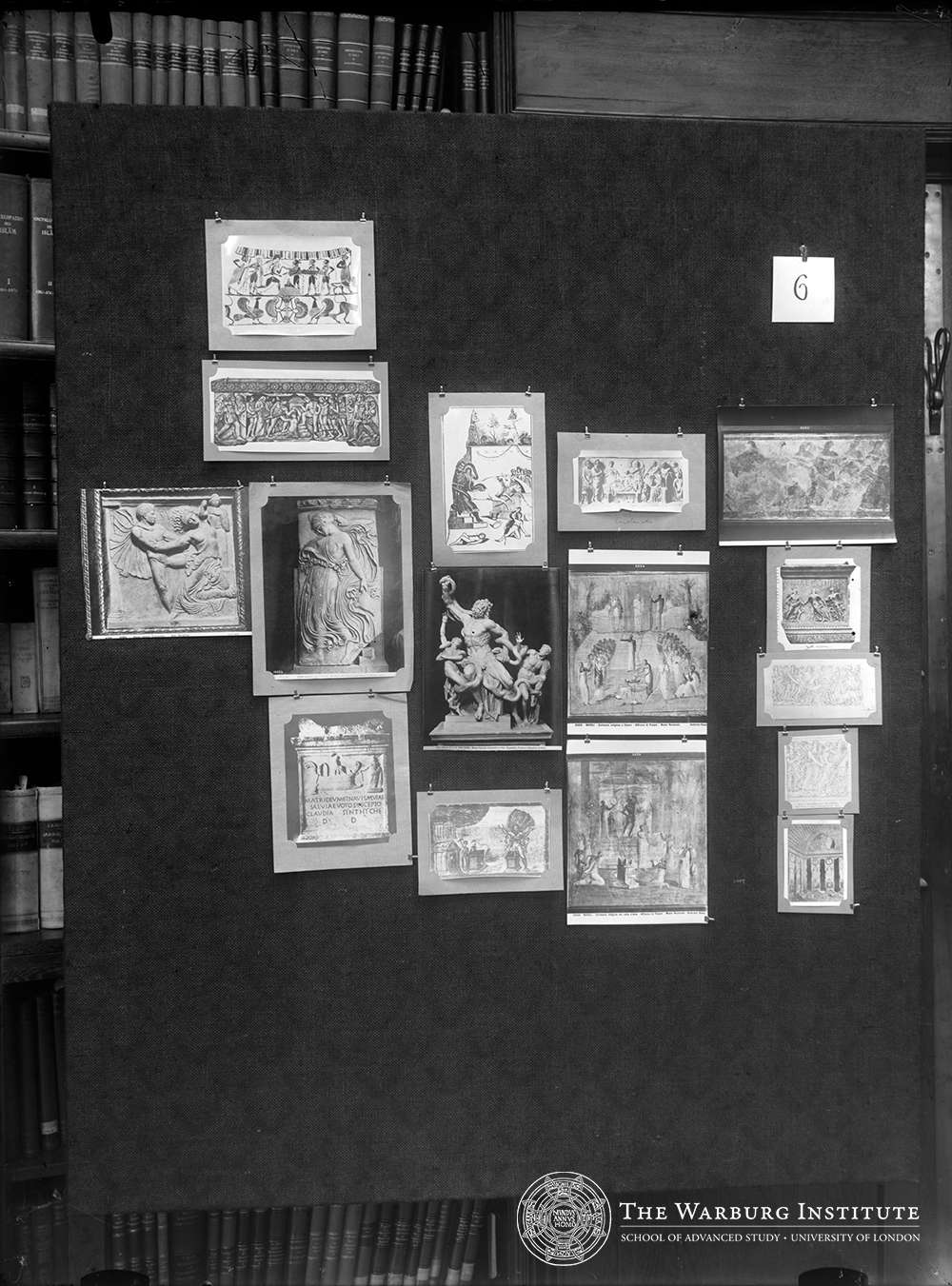
Appunti di Aby Warburg (1929)
Kult (Tanz)
Culto (danza).
Appunti di Aby Warburg e collaboratori (1929)
Antike Vorprägungen
Raub (Proserpina, Unterwelt [Tafel 5]). Opfer (Polyxena). Opfernde Mänade (Priesterin). Tod des Priesters (Laokoon). Conclamatio. Tanz des Priesters (Isis). Grabtä nzerinnen. Achill auf Skyros (als Chorführer?).
Preconiazioni antiche
Ratto (Proserpina, mondo infero [tavola 5]). Vittima sacrificale (Polissena). Menade sacrificante (sacerdotessa). Morte del sacerdote (Laocoonte). Conclamatio. Danza del sacerdote (Iside). Danzatrici funebri. Achille a Skyros (come capocoro?).
Appunti di Gertrud Bing (1940 ca)
Kult – Mysterien. Opfer der Polixena. Ajax (gleicher Sagenkreis) raubt Kassandra, diese – herische Priesterin. Mänade im thiasotischen Rausch. Cybele (synkretistischer Mysterien kult) zieht auf d. Schiff in Rom ein. Laokoon, Seher, Priester, stirbt. Das steht zur den ganzen Komplex des geopferten Priesterkönigs. Was bedeutet hier die Conclamatio?Pompeijanische Fresken bedeuten Verwandlung des Priesters. Wieso? Totenreigen. Dionysischer Reigen. Warum Achill auf Skyros hier?
Culto – Misteri. Sacrificio di Polissena. Aiace (leggenda analoga) rapisce Cassandra, la sacerdotessa veggente. Menade in stato di ebrezza tiasotica. Cibele (culto misterico sincretico) arriva a Roma su una nave. Laocoonte, veggente, e sacerdote, muore. Questo sta a significare l’intero concetto del del re-sacerdote sacrificato. Che significato ha qui la Conclamatio? Gli affreschi pompeiani stanno a significare un cambiamento [nella rappresentazione] del sacerdote. Come mai? Danza rituale funeraria. Danza rituale dionisiaca. Perché qui Achille a Sciro?
Notes by Aby Warburg (1929)
Kult (Tanz)
Cult (dance).
Notes by Aby Warburg and coll. (1929)
Antike Vorprägungen
Raub (Proserpina, Unterwelt [Tafel 5]). Opfer (Polyxena). Opfernde Mänade (Priesterin). Tod des Priesters (Laokoon). Conclamatio. Tanz des Priesters (Isis). Grabtä nzerinnen. Achill auf Skyros (als Chorführer?).
Precoinages from Antiquity
Rape (Proserpina, underworld [Panel 5]). Sacrifice (Polyxena). Sacrificing maenad (priestess). Death of the priest (Laokoon). Calling the name of the dead. The priest’s dance (Isis). Female funerary dancers. Achille on Skyros (as chorus leader?).
Notes by Gertrud Bing (ca. 1940)
Kult – Mysterien. Opfer der Polixena. Ajax (gleicher Sagenkreis) raubt Kassandra, diese – herische Priesterin. Mänade im thiasotischen Rausch. Cybele (synkretistischer Mysterien kult) zieht auf d. Schiff in Rom ein. Laokoon, Seher, Priester, stirbt. Das steht zur den ganzen Komplex des geopferten Priesterkönigs. Was bedeutet hier die Conclamatio?Pompeijanische Fresken bedeuten Verwandlung des Priesters. Wieso? Totenreigen. Dionysischer Reigen. Warum Achill auf Skyros hier?
Cult – Mysteries. Sacrifice of Polyxena. Ajax (similar legend) abducts Cassandra, the seer priestess. Maenad in a state of thiasotic intoxication. Cybele (syncretic mystery cult) arrives in Rome on a ship. Laocoon, seer and priest, dies. This stands for the whole complex of the sacrificed priest-king. What does the Conclamatio mean here? The Pompeian frescoes signify a change [in the representation] of the priest. Why? Funeral ritual dance. Dionysian ritual dance. Why Achilles in Skyros here?
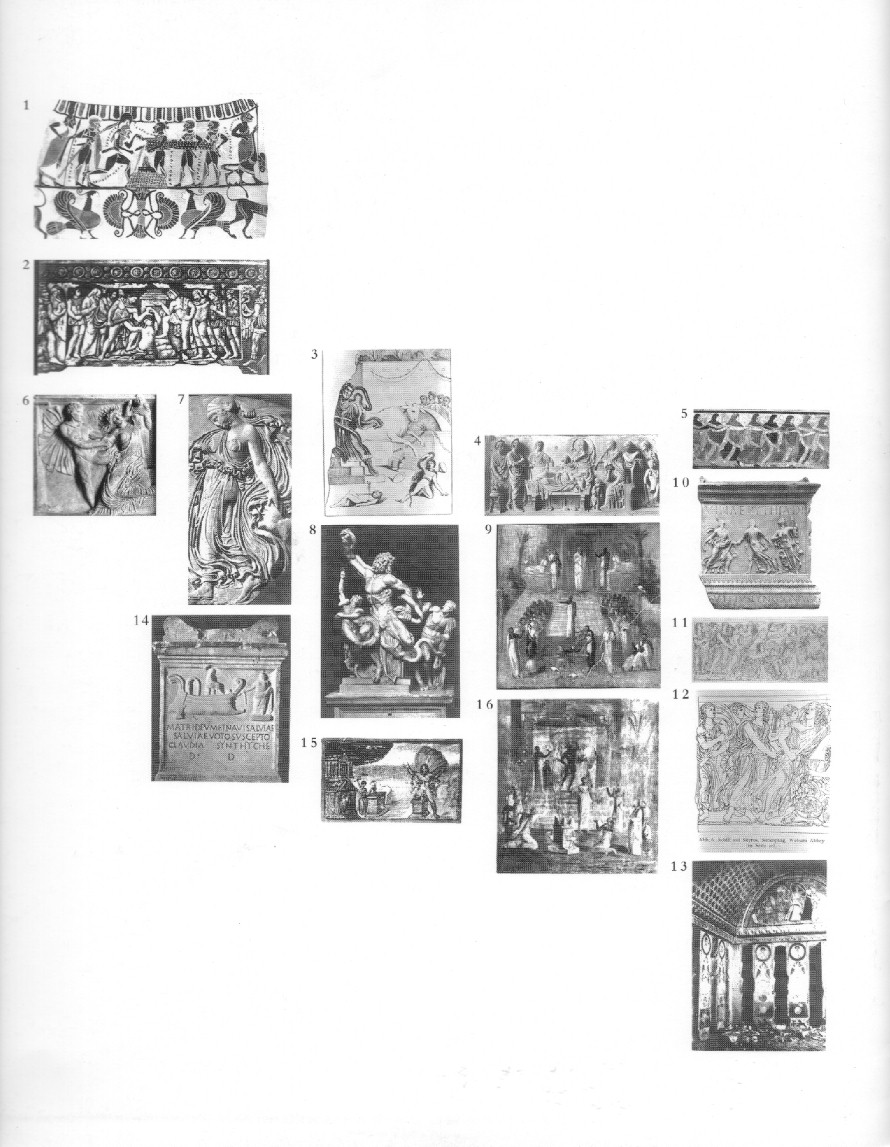
1. Sacrificio di Polissena, disegno della fascia esterna di un'anfora attica del 560 a.C. ca., London, The British Museum .
2. Sacrificio di Polissena, sarcofago etrusco in pietra, 300 a.C., Orvieto, Museo dell'Opera del Duomo.
3. Laocoonte e i suoi figli assaliti dai serpenti, disegno di pittura parietale da Pompei, Casa di Laocoonte, III stile, 30 a.C.- 62 d.C. ca., Napoli, Museo Archeologico Nazionale.
4. Conclamatio, bassorilievo veneziano, inizio del sec. XVI, Paris, Musée du Louvre.
5. Danza rituale funeraria, particolare di una pittura parietale da Ruvo, seconda metà del sec. IV a.C., Napoli, Museo Nazionale.
6. Aiace e Cassandra, bassorilievo ellenistico, fine sec. IV a.C., Roma, Villa Borghese .
7. Menade danzante, bassorilievo neoattico da un originale di Kallimachos della fine V sec. a.C., fine sec. II a.C., Roma, Museo dei Conservatori.
8. Gruppo di Laocoonte, gruppo marmoreo di Athanadoros, Hagesandros e Polydoros, scuola rodia, sec. II a.C.-I d.C. (?) Roma, Musei Vaticani.
9. Culto di Iside, il sacerdote presenta il vaso con acqua santa tra file di persone che cantano, pittura parietale da Ercolano, 50-75 d.C. ca., Napoli, Museo Archeologico Nazionale.
10. Menadi danzanti, altare sepolcrale di Vibia Pytia, Kopenhagen, Ny Carlsberg Glyptothek.
11. Achille e Daidamia a Skyros, disegno da un sarcofago romano, Bedfordshire, Woburn Abbey .
12. Achille e Daidamia a Skyros, disegno da un sarcofago romano, Bedfordshire, Woburn Abbey, riproduzione da Aby Warburg, Sandro Botticellis "Geburt der Venus" und "Frühling", Straßburg 1892, ill. 4.
13. Achille e Daidamia a Skyros, affresco della lunetta dell'Ipogeo dei Fratelli, seconda metà II sec. d.C.-prima metà III sec. d.C., Palmira.
14. La vestale Claudia Quinta accoglie l'imbarcazione di Cibele a Roma, altare marmoreo romano, 40-60 d.C., Roma, Musei Capitolini.
15. Laocoonte, illustrazione da un manoscritto virgiliano, sec. IV-V d.C., Cod. Vat. lat. 3225, fol. 18v, Roma, Biblioteca Vaticana.
16. Culto di Iside, mentre sull'altare arde un sacrificio, un sacerdote mascherato esegue fuori del tempio una danza rituale, accompagnato dai canti dei fedeli, pittura parietale da Ercolano, 45-79 d.C. ca., Napoli, Museo Archeologico Nazionale.
1. Sacrifice of Polyxena. Drawing from: H. B. Walters, The Journal of Hellenic Studies, 18, 1898, tbl. 15 | Black figure amphora (38x24cm), 570-550 BC. London, British Museum, Department of Greek and Roman Antiquities.
2. Sacrifice of Polyxena, sarcophagus relief (96x 210 x80 cm.), IV century BC. Orvieto, Museo dell’Opera del Duomo.
3. Death of Laocoön. Reproduction of a fresco originally from Pompeii, Casa di Laooconte, AD 30-50 c., today in Naples, Museo Archeologico Nazionale.
4. Conclamatio (Funerary Ceremony), marble relief (83 x 200 cm.), early XVI century. Paris, Musée du Louvre.
5. Ritual funerary dance (detail), mural painting, V century BC. Naples, Museo Archeologico Nazionale (originally from Ruvo di Puglia, Tomb n. 11).
6. Ajax the Lesser and Cassandra, marble relief (84 x 84 cm. c.), I century BC (Roman copy of an original V century Greek relief). Rome, Villa Borghese.
7. Dancing Menenad. Roman copy of an original by Kallimachos from the 406-405 century BC, marble relief (143x71 cm.), 27 BC-AD 14. Rome, Musei Capitolini, Museo dei Conservatori.
8. Athanadoros, Hagesandros e Polydoros, Laocoön and his Sons, marble sculpture (208 x 163 x 112 cm.), late I-II century BC. Vatican City, Musei Vaticani, Cortile del Belvedere.
9. Ritual Ceremony of the Cult of Isis (the priest presents the vessel of holy water between rows of singing worshippers), fresco (96x96,5 cm.), AD 50-75. Naples, Museo Archeologico Nazionale (originally from Herculaneum).
10. Dancing Maenads (funerary altar of Vibia Pytia), marble relief (80x 79 cm.), AD 80-100. Copenhagen, Ny Carlsberg Glyptothek.
11. Achilles on Skyros. Outline drawing of a Roman sarcophagus relief, AD 250-260 c., today in Woburn Abbey, Bedfordshire.
12. Achilles on Skyros (detail of 6_11). Outline drawing of a Roman sarcophagus relief, AD 250-260 c., today in Woburn Abbey, Bedfordshire.
13. Achilles on Skyros, fresco, late 3rd century. Palmyra, Tomb of the Three Brothers.
14. Altar of Cybele, marble relief (87x 59 x 51 cm.), AD 37-54. Rome, Musei Capitolini.
15. Death of Laocoön. From: Virgil, manuscript illumination (22,5 x 20 cm.), IV AD. Vatican City, Biblioteca Apostolica Vaticana, Cod. Vat. lat. 3225, fol. 18v.
16. Ritual Ceremony of the Cult of Isis (dance of the priest during the sacrificial burning, accompanied by songs of the worshippers), fresco (96x92 cm.), AD 50-75. Naples, Museo Archeologico Nazionale (originally from Herculaneum).
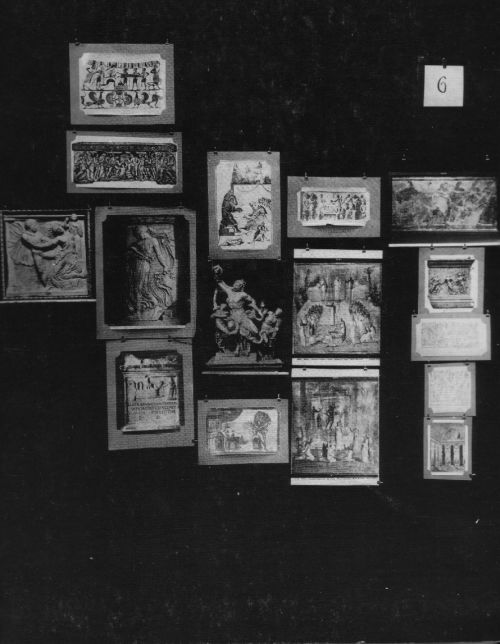
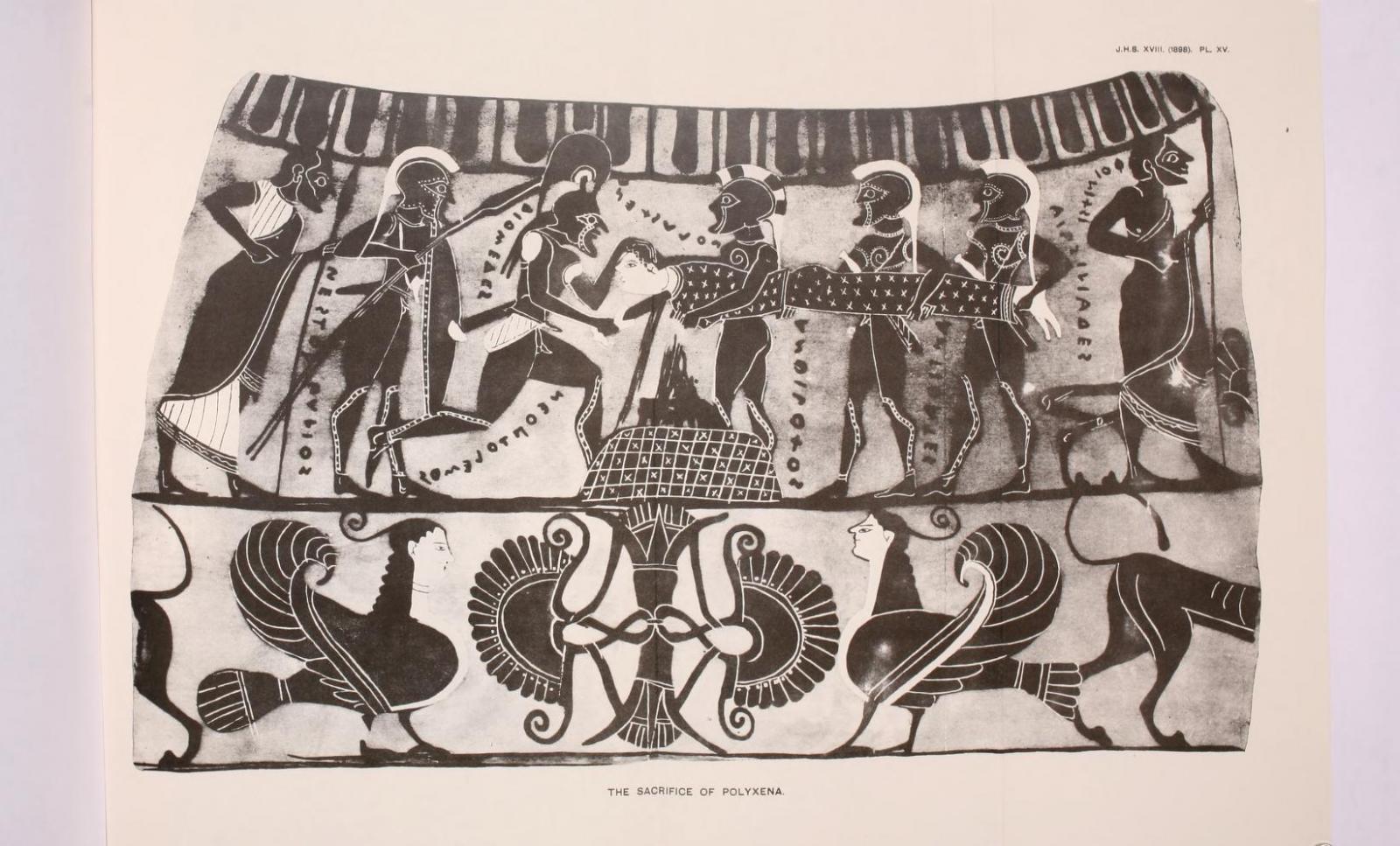
6_1 | Sacrificio di Polissena, disegno della fascia esterna di un'anfora attica del 560 a.C. ca., Londra, The British Museum. Tratto da H. B. Walters, The Journal of Hellenic Studies, 18, 1898, tav. 15.
In Tavola: riproduzione fotografica.
6_1 | Sacrifice of Polyxena. Drawing from: H. B. Walters, The Journal of Hellenic Studies, 18, 1898, tbl. 15 | Black figure amphora (38x24cm), 570-550 BC. London, British Museum, Department of Greek and Roman Antiquities.
In Tavola: photographic reproduction.
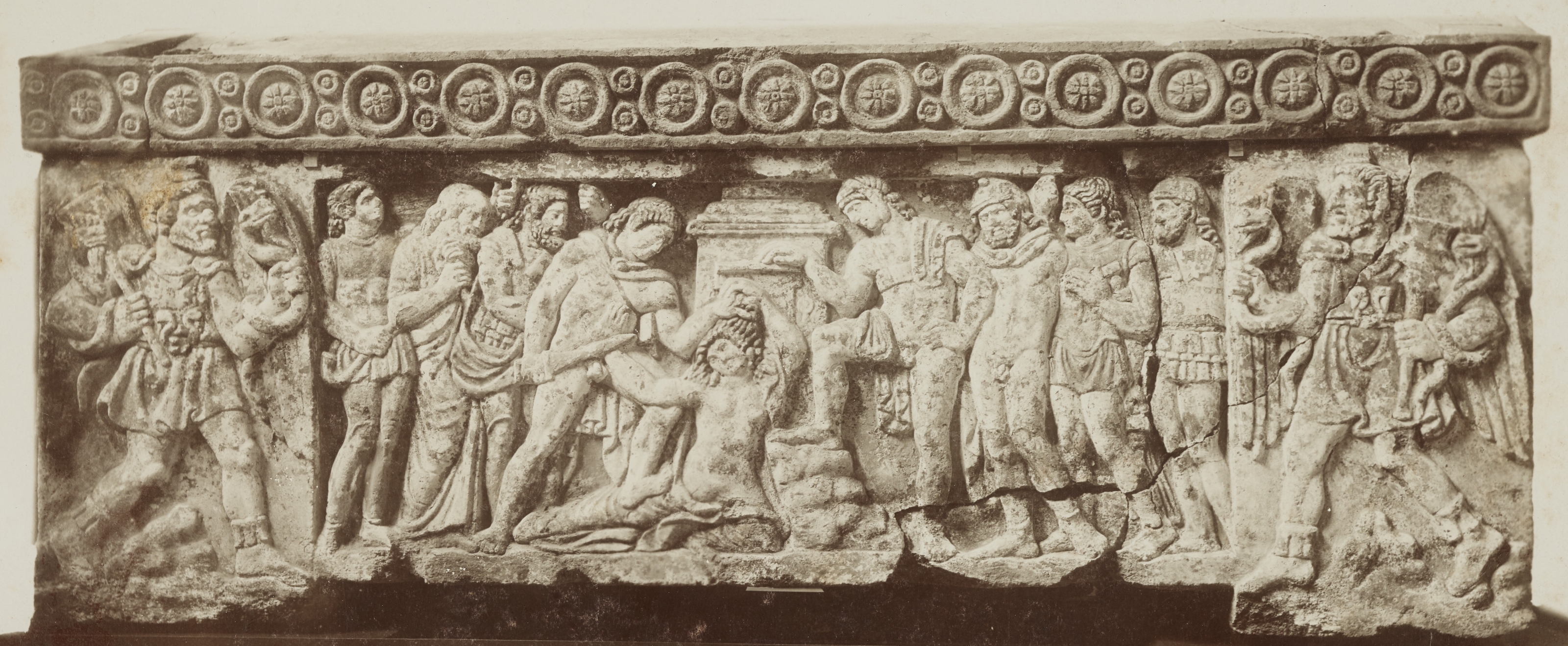
6_2 | Sacrificio di Polissena, sarcofago etrusco in pietra (96x 210 x80 cm.), IV sec. a.C., Orvieto, Museo dell'Opera del Duomo.
In Tavola: riproduzione fotografica.
6_2 | Sacrifice of Polyxena, sarcophagus relief (96x 210 x80 cm.), IV century BC. Orvieto, Museo dell’Opera del Duomo.
In the panel: photographic reproduction.
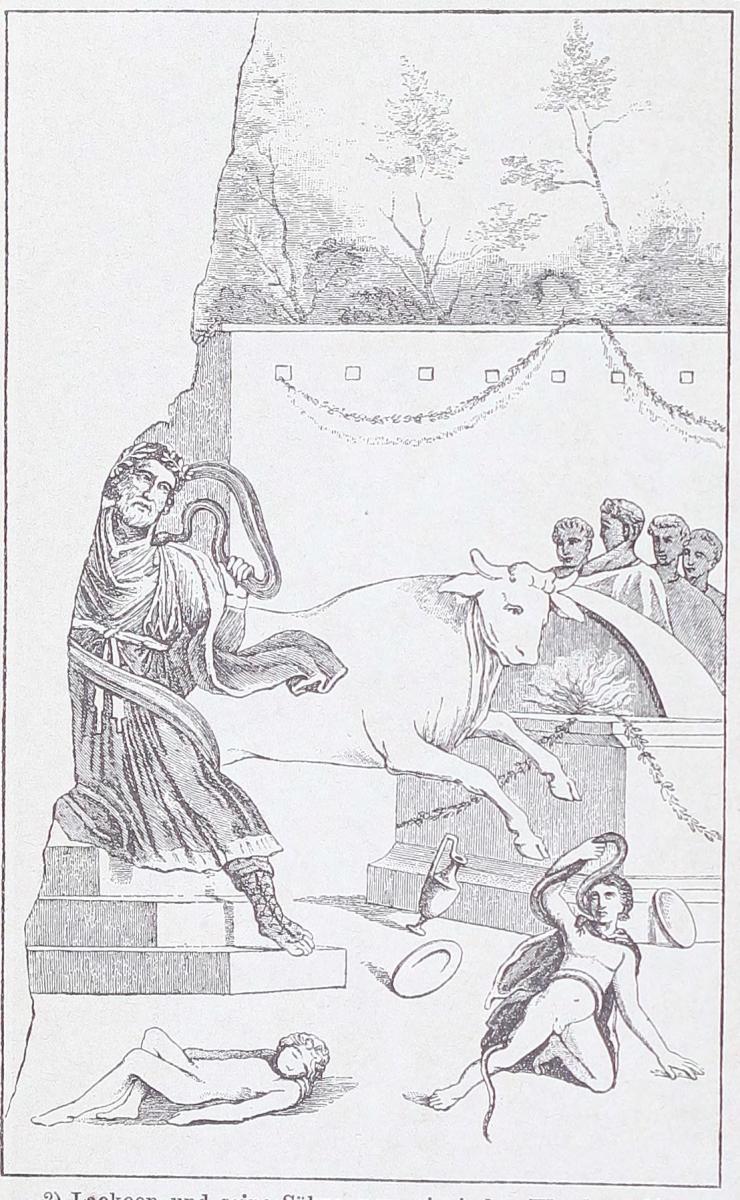
6_3 | Laocoonte e i suoi figli assaliti dai serpenti, disegno di pittura parietale da Pompei, Casa di Laocoonte, III stile, 30 a.C.- 62 d.C. ca., Napoli, Museo Nazionale. Tratto da W.H. Röscher, Ausführliches Lexikon der griechischen und römischen Mythologie, vol. 2, Leipzig 1890-1897, p. 1839, ill. 2, s.v. Laokoon
In Tavola: riproduzione fotografica.
6_3 | Death of Laocoön. Reproduction of a fresco originally from Pompeii, Casa di Laooconte, AD 30-50 c., today in Naples, Musco Archcologico Nazionale. From: W.H. Röscher, Ausführliches Lexikon der griechischen und römischen Mythologie, vol. 2, Leipzig 1890-1897, p. 1839, ill. 2, s.v. Laokoon
In the panel: photographic reproduction.
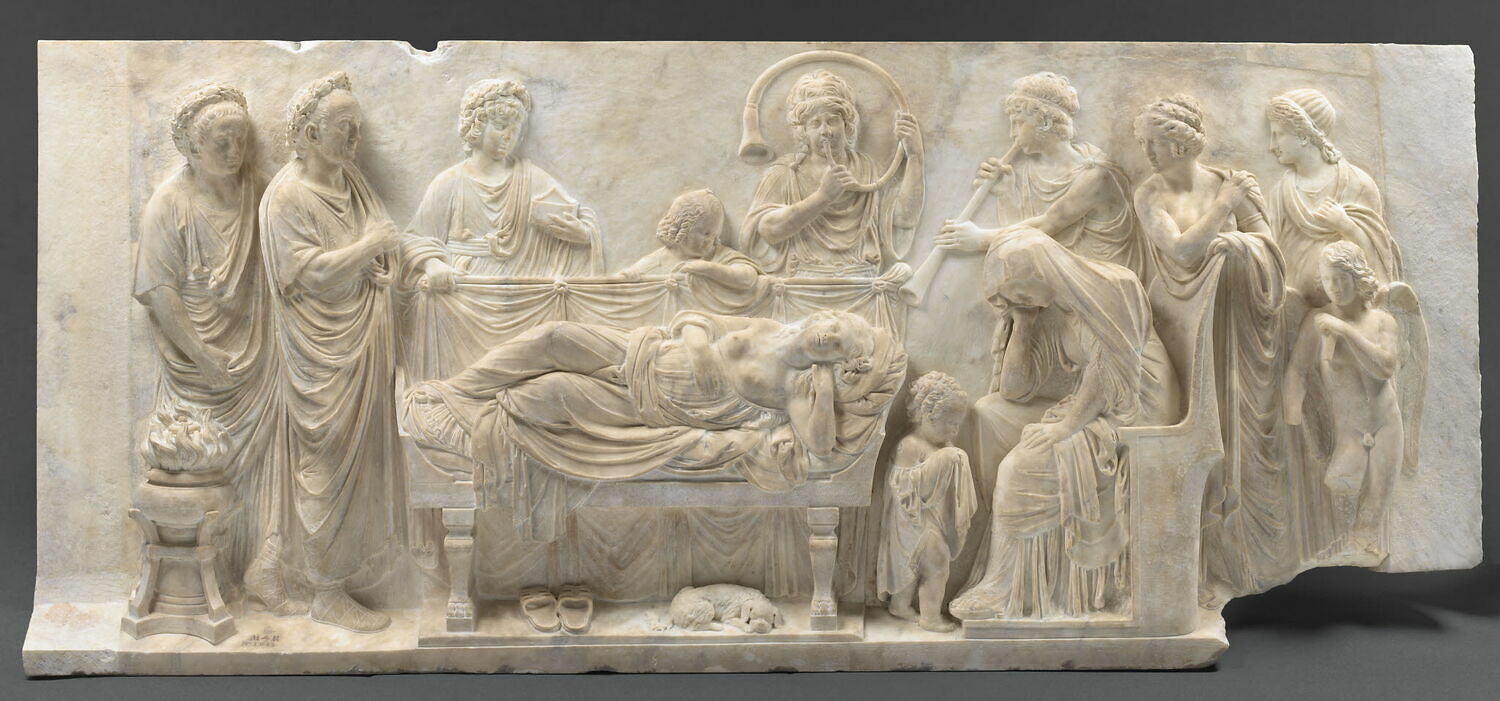
6_4 | Conclamatio (cerimonia funebre), bassorilievo veneziano (83 x 200 cm.), inizio del sec. XVI, Parigi, Museo del Louvre.
In Tavola: riproduzione fotografica.
6_4 | Conclamatio (Funerary Ceremony), marble relief (83 x 200 cm.), early XVI century. Paris, Musée du Louvre.
In the panel: photographic reproduction.
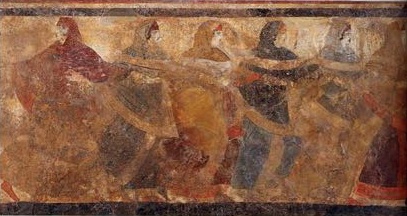
6_5 | Danza rituale funeraria, particolare di una pittura parietale da Ruvo, seconda metà del sec. IV a.C., Napoli, Museo Nazionale.
In Tavola: riproduzione fotografica.
6_5 | Ritual funerary dance (detail), mural painting, V century BC. Naples, Museo Archeologico Nazionale (originally from Ruvo di Puglia, Tomb n. 11).
In the panel: photographic reproduction.
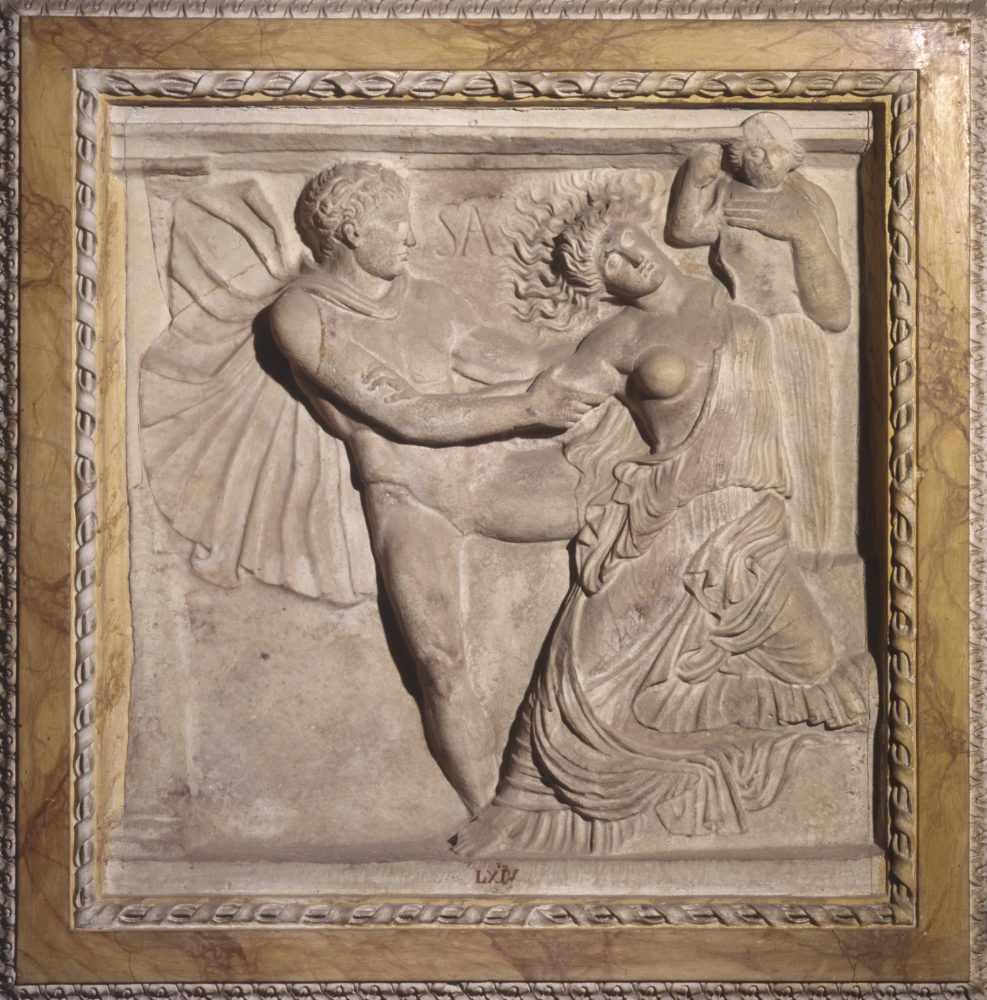
6_6 | Aiace e Cassandra, bassorilievo ellenistico (84 x 84 cm. c.), fine sec. IV a.C. Roma, Villa Borghese.
In Tavola: riproduzione fotografica.
6_6 | Ajax the Lesser and Cassandra, marble relief (84 x 84 cm. c.), I century BC (Roman copy of an original V century Greek relief). Rome, Villa Borghese.
In the panel: photographic reproduction.
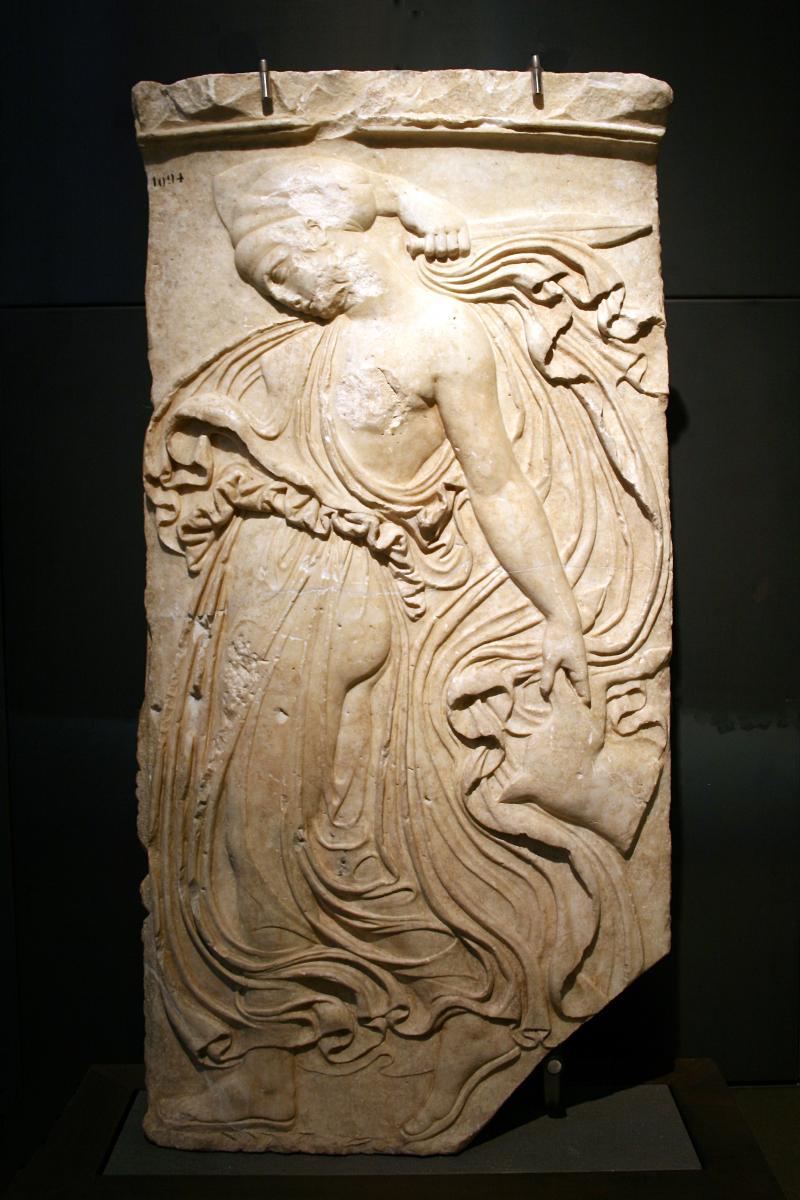
6_7 | Menade danzante, bassorilievo neoattico da un originale di Kallimachos della fine V sec. a.C., rilievo in marmo (143x71 cm.), età augustea (27 a.C.-14d.C.), Roma, Museo dei Conservatori.
In Tavola: riproduzione fotografica.
6_7 | Dancing Menenad. Roman copy of an original by Kallimachos from the 406-405 century BC, marble relief (143x71 cm.), 27 BC-AD 14. Rome, Musei Capitolini, Museo dei Conservatori.
In the panel: photographic reproduction.
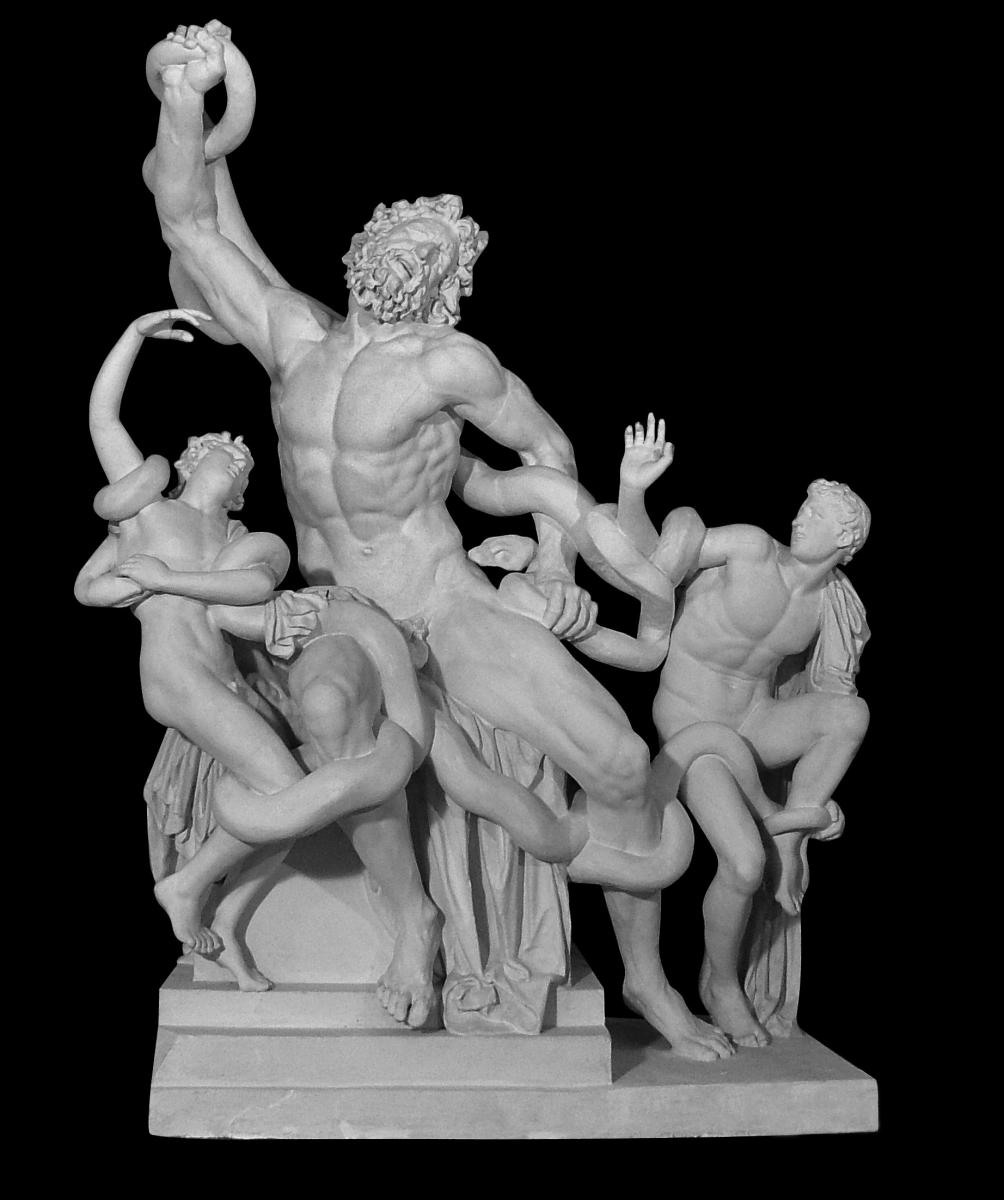
6_8 | Athanadoros, Hagesandros e Polydoros, Gruppo del Laocoonte, gruppo marmoreo di scuola rodia (208 x 163 x 112 cm.), sec. II a.C.-I d.C. (?). Roma, Musei Vaticani.
In Tavola: riproduzione fotografica.
6_8 | Athanadoros, Hagesandros e Polydoros, Laocoön and his Sons, marble sculpture (208 x 163 x 112 cm.), late I-II century BC. Vatican City, Musei Vaticani, Cortile del Belvedere.
In the panel: photographic reproduction.
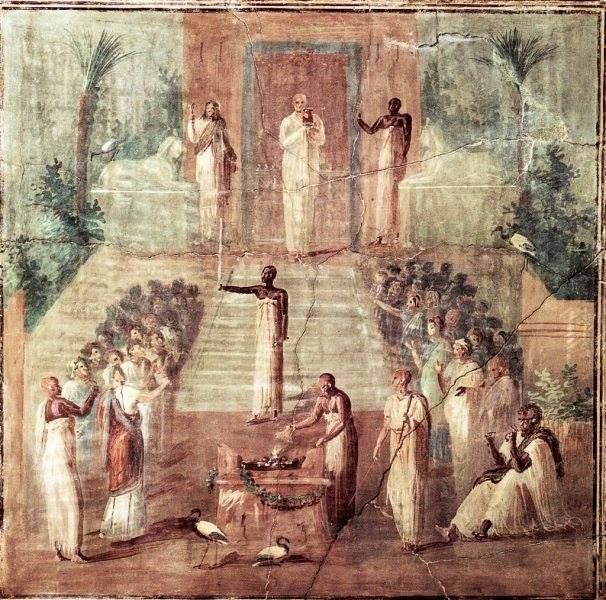
6_9 | Culto di Iside (il sacerdote presenta il vaso con acqua santa tra file di persone che cantano), affresco da Ercolano (96x96,5 cm.), 50-75 d.C. ca., Napoli, Museo Archeologico Nazionale.
In Tavola: riproduzione fotografica.
6_9 | Ritual Ceremony of the Cult of Isis (the priest presents the vessel of holy water between rows of singing worshippers), fresco (96x96,5 cm.), AD 50-75. Naples, Museo Archeologico Nazionale (originally from Herculaneum).
In the panel: photographic reproduction.
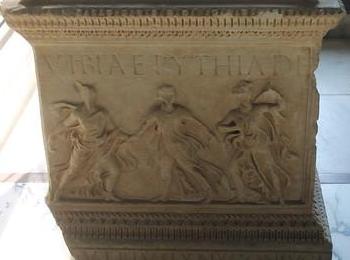
6_10 | Menadi danzanti, altare sepolcrale di Vibia Pytia, rilievo in marmo (80x 79 cm.), 80-100 d. C. Kopenhagen, Ny Carlsberg Glyptothek.
In Tavola: riproduzione fotografica.
6_10 | Dancing Maenads (funerary altar of Vibia Pytia), marble relief (80x 79 cm.), AD 80-100. Copenhagen, Ny Carlsberg Glyptothek.
In the panel: photographic reproduction
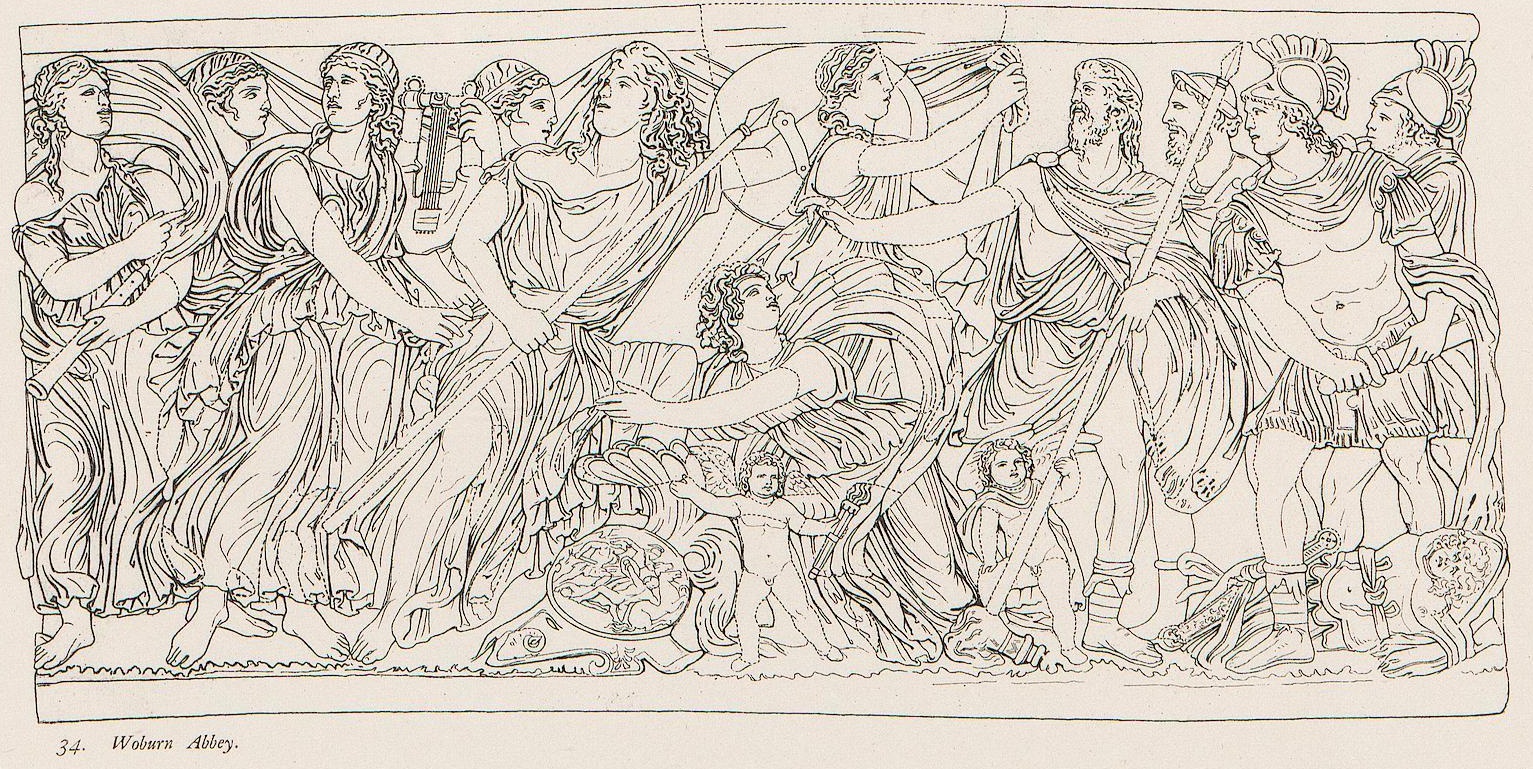
6_11 | Achille e Daidamia a Skyros, disegno da un sarcofago romano, 250-260 d. C. Bedfordshire, Woburn Abbey. Tratto da Carl Robert, Die antiken Sarkophagreliefs, vol. II, Berlin 1890, tav. 19, fig. 34.
In Tavola: riproduzione fotografica.
6_11 | Achilles on Skyros. Outline drawing of a Roman sarcophagus relief, AD 250-260 c., today in Woburn Abbey, Bedfordshire. From: Carl Robert, Die antiken Sarkophagreliefs, vol. II, Berlin 1890, tbl. 19, fig. 34.
In the panel: photographic reproduction
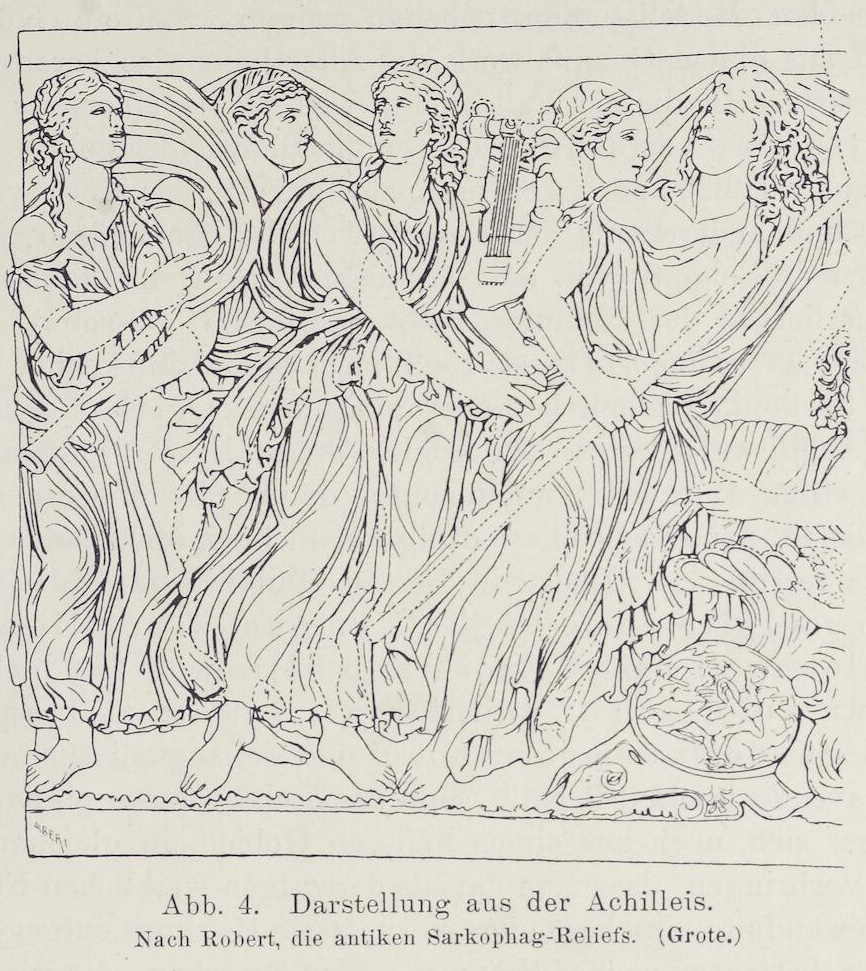
6_12 | Achille e Daidamia a Skyros, disegno da un sarcofago romano, 250-260 d. C. Bedfordshire, Woburn Abbey. Tratto da Aby Warburg, Sandro Botticellis, Geburt der Venus und Frühling, Straßburg 1892, p. 15, ill. 4.
In Tavola: riproduzione fotografica.
6_12 | Achilles on Skyros (detail of 6_12). From: Aby Warburg, Sandro Botticellis Geburt der Venus und Frühling, Phil. Diss. Strasbourg 1892, p. 15, ill. 4.
In the panel: photographic reproduction
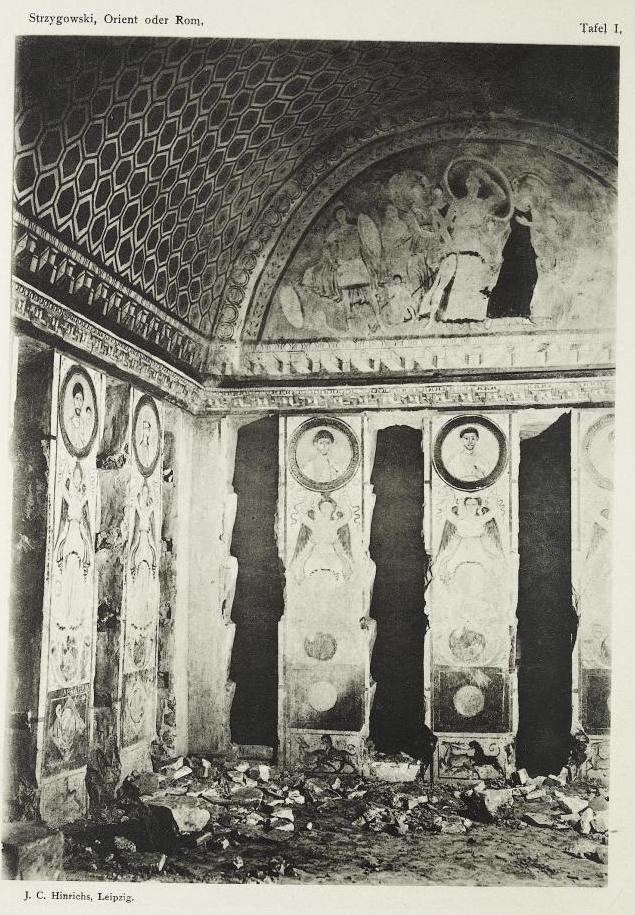
6_13 | Achille e Daidamia a Skyros, affresco, seconda metà II sec. d.C.-prima metà III sec. d.C. Palmira, lunetta dell’Ipogeo dei Fratelli. Tratto da J. Strzygowski, Orient oder Rom. Beiträge zur Geschichte der spätantiken und frühchristlichen Kunst, Leipzig 1901, tav. 1.
6_13 | Achilles on Skyros, fresco, late 3rd century. Palmyra, Tomb of the Three Brothers. From J. Strzygowski, Orient oder Rom. Beiträge zur Geschichte der spätantiken und frühchristlichen Kunst, Leipzig 1901, tbl. 1.
In the panel: photographic reproduction
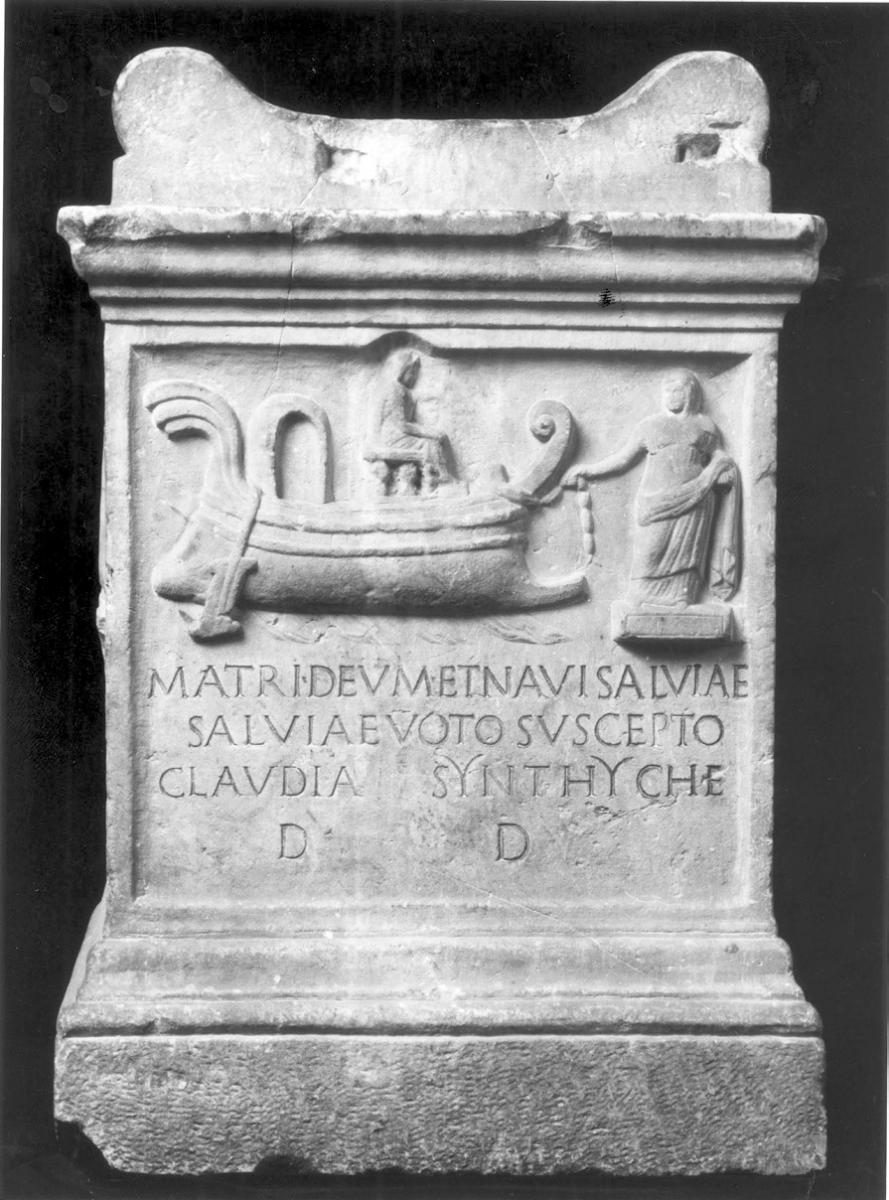
6_14 | La vestale Claudia Quinta accoglie l'imbarcazione di Cibele a Roma, altare marmoreo romano (87x 59 x 51 cm.), 40-60 d.C., Roma, Musei Capitolini
In Tavola: riproduzione fotografica.
6_14 | Altar of Cybele, marble relief (87x 59 x 51 cm.), AD 37-54. Rome, Musei Capitolini.
In the panel: photographic reproduction
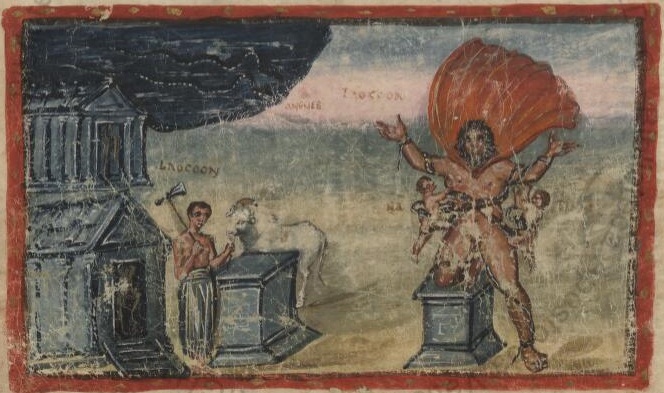
6_15 | Laocoonte, illustrazione da un manoscritto virgiliano (22,5 x 20 cm.), sec. IV d.C. Roma, Biblioteca Vaticana, Cod. Vat. lat. 3225, fol. 18v.
In Tavola: riproduzione fotografica.
6_15 | Death of Laocoön. From: Virgil, manuscript illumination (22,5 x 20 cm.), IV AD. Vatican City, Biblioteca Apostolica Vaticana, Cod. Vat. lat. 3225, fol. 18v.
In the panel: photographic reproduction
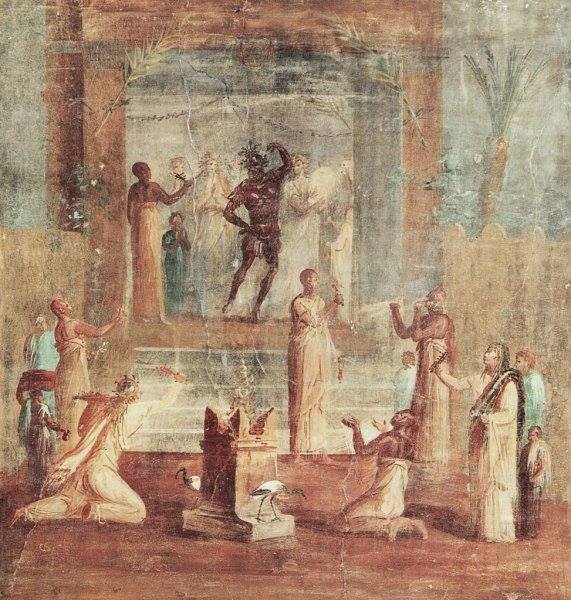
6_16 | Culto di Iside (mentre sull'altare arde un sacrificio, un sacerdote mascherato esegue fuori del tempio una danza rituale, accompagnato dai canti dei fedeli), affresco da Ercolano (96x92 cm.), 50-75 d.C. ca., Napoli, Museo Archeologico Nazionale.
In Tavola: riproduzione fotografica.
6_16 | Ritual Ceremony of the Cult of Isis (dance of the priest during the sacrificial burning, accompanied by songs of the worshippers), fresco (96x92 cm.), AD 50-75. Naples, Museo Archeologico Nazionale (originally from Herculaneum).
In the panel: photographic reproduction

